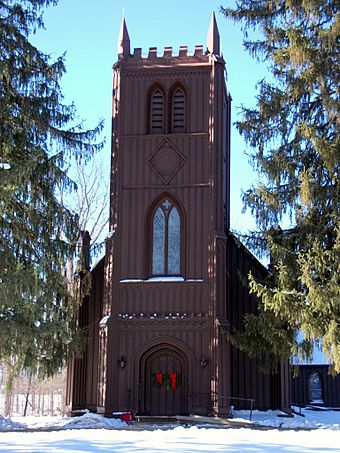Church of St. John the Evangelist (Stockport, New York) facts for kids
Quick facts for kids |
|
|
Church of St. John the Evangelist
|
|

Church of St. John the Evangelist, January 2011
|
|
| Location | Chittenden Rd., Stockport, New York |
|---|---|
| Area | 0 acres (0 ha) |
| Built | 1846 |
| Architectural style | Gothic Revival |
| NRHP reference No. | 72000827 |
| Added to NRHP | April 13, 1972 |
The Church of St. John the Evangelist was a special historic church located in Stockport, New York. It was an Episcopal church building. The church was finished in August 1846. It was officially dedicated on July 3, 1847. This church was the very first Episcopal church built in Columbia County, New York.
The church building was a one-story, rectangular structure made of wood. It was built in a style called Carpenter Gothic. It was painted a deep brown color. Because of its color, people in the area lovingly called it "The Little Brown Church."
Contents
A Look Inside the Church
The Church of St. John the Evangelist had a tower at its center entrance. This tower held a cast iron church bell. The main entrance had double doors and beautiful stained glass windows. Inside the entrance was a simple area called a vestibule. Here, you could find the rope for the bell. There was also a plaque honoring Joseph Marshall. He was the person who built the church. His remains are buried beneath where the north transept used to be. Joseph Marshall was born in England in 1773. He moved to America in 1827. He built St. John's Church in 1846 and passed away in 1848.
Church Design and Features
The church had steep gable roofs. These roofs protected the main part of the building. Inside, there was an organ loft, a nave (the main seating area), a chancel, and a sanctuary. The north and south walls of the nave each had four lovely stained glass windows. At the northwest corner of the building was a former sacristy. This area used to be the organ chamber. Another sacristy was located at the southwest corner. Next to the church was a cemetery. About 2,200 people have been buried there since 1821.
A National Historic Site
On April 13, 1972, the Church of St. John the Evangelist became a national historic site. It was added to the National Register of Historic Places. This happened after two years of research by Helen M. Ofield. This honor recognized the church's beautiful architecture. It also celebrated its importance as an American country church.
Church and Town History
The town of Stockport and the church grew up together. Many people who built, attended, or supported the church were involved with the textile mills in Stockport. They were either mill owners or employees. The church fit perfectly into Stockport. It was a quiet town with many houses built before the Civil War.
Important Nearby Buildings
South of the church stood three houses. These were originally built by Joseph Marshall, the church's builder. Across from the church was "Maple Lawn." This Italianate Revival home was built in 1853. It belonged to Rensselaer Reynolds, an inventor. He designed and operated the first electrically powered textile loom. His family also helped support the church. His son, Robert Burns Reynolds, built a charming Victorian home in 1888. This home, called "The Grove," was next to the south side of the church cemetery. All these homes are still standing today. Also across from the church is an 1816 brick house. Captain Seth Macy built this house. He was a famous captain who sailed to China. Macy sold the house to Joseph Marshall in 1828.
Stockport's Beginnings
The history of Stockport is connected to the economy of Europe. In the early 1800s, economic problems hit Stockport, England. These problems caused many families to move. One young man, James Wild, left England for America in 1806. He wanted to invest his family's money in making textiles. Around 1808, he settled in New York State. He chose a spot where two streams met the Hudson River. He began to build up the area. He named his new town Stockport, after his hometown in England.
The Church Today
The Church of St. John the Evangelist is no longer standing. It was taken down in 2019. The church diocese hired an antiques dealer to remove the building.



